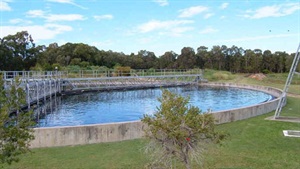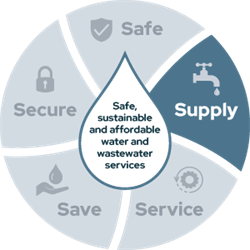Wastewater treatment plants
 Council sustainably operates and maintains 8 wastewater treatment plants, helping protect the health of the Tweed community and our natural environment.
Council sustainably operates and maintains 8 wastewater treatment plants, helping protect the health of the Tweed community and our natural environment.
Our treatment plants use a range of processes to remove debris and treat our wastewater in ways that minimise our impact on the environment.
Treated water flows out to our rivers and is:
- used for irrigation of cane fields
- sent to Chinderah Golf Course for reuse
- used to irrigate Koala food trees grown for Currumbin Sanctuary
The Condong Sugar Mill reuses about 30% of the treated water from the Murwillumbah treatment plant.
Treatment process
When raw sewage arrives at a wastewater treatment plant, it contains material that has to be removed before it can be returned to the river or land:
- wet wipes and non-flushable items (nappies, sanitary items, toys)
- household and industrial chemicals
- disease-causing viruses and bacteria
- organic matter
- heavy metals
- sediment
- grease
- insecticides
- nutrients such as phosphates and nitrates
Primary treatment: removing solids, grease and sediment
Wastewater is passed through screens to remove inorganic solids.
Secondary treatment: removing organic matter and nutrients
A biological process where naturally occurring micro-organisms break down organic matter and nutrients.
This involves the use of bio-reactors, activated sludge tanks and oxidation ponds, followed by settling tanks or clarifiers to separate micro-organisms from the purified liquid.
Secondary treatment at most sites includes removal of nutrients, such as nitrogen and phosphorus.
Tertiary treatment: removing pathogens that pose a risk to human health
- Chlorination followed by dechlorination.
- Holding effluent for at least 10 days in ponds where sunlight and other micro-organisms reduce pathogens.
- Filtering using microfiltration or cloth filters.
- Ultra violet and/or gamma radiation.
Additional treatments are required if the treated wastewater is reused for purposes such as irrigating food crops, for example sugar cane, or where it comes in close contact with people, such as sports fields.
Wastewater treatment plants
Banora Point

Services: Tweed Heads, Banora Point, Terranora, Bilambil Heights
Capacity: Up to 18 megalitres per day, approximately 75,000 people
Solar array: 1,208 high-efficiency panels, 604 kilowatt capacity
Hastings Point
Services: Hastings Point, Bogangar/Cabarita, Pottsville
Capacity: Up to 4.3 megalitres per day, 18,000 people
This plant is set to undergo a performance upgrade.
Kingscliff
Services: Kingscliff, Fingal, Chinderah, Cudgen, South Kingscliff (Salt), Casuarina
Capacity: 6 megalitres per day, 25,000 people
Mooball
Services: Burringbah, Mooball
Capacity: 180 kilolitres per day, up to 750 people
Murwillumbah
Services: Tertiary Treated Effluent System
Capacity: Up to 3.8 megalitres per day, 16,000 people
Tumbulgum
Services: Tumbulgum
Capacity: 168 kilolitres per day, up to 700 people
Tyalgum
Services: Tyalgum
Capacity: 120 kilolitres per day, up to 500 people
Uki
Services: Uki
Capacity: 190 kilolitres per day, 800 people
Typical wastewater testing parameters and result ranges
| Range |
Amount |
| Normal river quality |
< 5 mg/L BOD5 |
| Flood river quality |
> 1000 mg/L BOD5 |
| Sewage into the treatment plants |
250 mg/L BOD5 and SS |
| Sewage after extended aeration |
20 mg/L BOD5 and SS |
| Final effluent discharged |
< 10 mg/L BOD5 and SS |
BOD5 refers to the Biochemical Oxygen Demand of the micro-organisms in a 5 day period.
SS refers to Suspended Solids
Environmental Protection Authority standards
The Environmental Protection Authority (EPA) sets the standards for the quality of water being discharged to our rivers and land.
Standards vary between treatment plants, depending on the sensitivity of the sewage (receiving waters) received, how well it is flushed and what it is used for.
Council publishes Pollution Incident Response Management Plans and pollution monitoring data.
